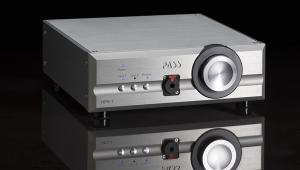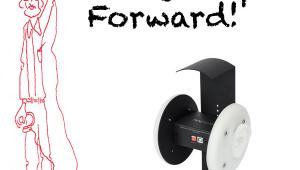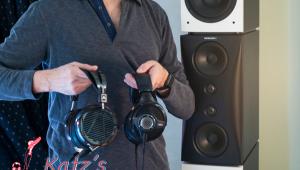| Columns Retired Columns & Blogs |
Katz's Corner Episode 18: Icelandic Wonder

This story originally appeared at InnerFidelity.com
Electrostatic Advances
I have a love affair with my Stax SR-007 Mk2 phones, which I judge to be superior, smoother, more musical and accurate than the expensive SR-009 model. What's with Stax? For them "better" seems to mean brighter, but why manufacture an even brighter headphone when the 007 model already sounds too bright? Stax seems to be obsessed with detail at the expense of musicality or even accuracy. But after-market amplifiers have sweetened that tune to a great extent.
I own the first-generation KGSS Stax amp, which Justin from Headamp constructed, and which I customized with hand-wired 1 dB/step input attenuators. I'm glad I asked Justin Wilson at HeadAmp to build this, because fiddling with high voltage is not my favorite pastime. I've enjoyed that amp with these phones for several years. I designed a custom EQ curve in the DMG Equilibrium plugin which helps remove the over-bright edge and make the Stax more accurate. But even with the EQ and even sourced from a superior DAC, at best I'd have to say these phones powered by the original KGSS sound more "analytical" than musical. So mostly I prefer the best dynamic cans for long-term musical listening. But my best dynamic cans are missing the high frequency extension of the electrostatics, even with EQ, so it's a tradeoff.
But this month things have totally changed—for the better, in both the Electrostatic and Dynamic departments! Spritzer of Mjölnir Audio, from the land of ice and snow, has sent me the new KGSS HV Carbon for review. This amp is at least 4 generations past my original KGSS, so I was very curious to hear the advances that the team of Spritzer and Kevin Gilmore have come up with. And I was not disappointed: The KGSS HV Carbon completely changes my perception of these phones. Their sound is now genuinely musical, punchy and clear, as loudly as I want to play them. Though I never play these phones louder than about 84-86 dB SPL on a double forte, and the average of pop music probably falls around 77 dB at mezzo forte. But you can swing this amp up further if you want to go deaf or momentarily impress yourself with very clean 90 dB averages.
Word of extreme caution: Do not demo headphones at 90 dB for any extended length of time. I advise no longer than 1 minute's worth, which will convince you of the clean power of the system, but then take it down to preserve your hearing. You don't have to play 90 dB levels to be impressed: On my favorite classical demo track, Vienna Philharmonic, Mahler Symphony No. 3, pianissimos are well below 70 dB, yet on the Stax every detail is still audible. The Vienna recording ranges from a shout to a whisper and I bathe in its dynamics, so well reproduced on the Carbon/Stax combination.
The Carbon has only one control, a smooth-feel balanced attenuator that's in front of the active circuitry, and which tracks audibly perfectly for a wide range of travel. A passive loop-through allows for daisy-chaining into another balanced input device. I use it to chain into my balanced dynamic headphone amplifier. Mjölnir has several versions of the Carbon at varying prices; visit their website to see what's available.
I absolutely love these phones now, driven by the Carbon. The sound is sweet, pure, and impacting, almost down to the lowest bass. The incestuous, liquid-sounding Carbon amp does not sacrifice any sonic detail. It's better with a touch of high frequency softening and bass boost, but fortunately, EQ has become optional. You can use EQ for low frequency extension and subtle high frequency smoothing rather than repair. Separation is superb, imaging and depth are as holographic as they can get with headphones—thanks to the large circumaural Stax diaphragms.
The KGSS HV Carbon is very "tube-like" and rich without any of the low end bloat or weakness often associated with tubes. Not all tube amps have such bass issues, by the way, but it would take a very good tube design to produce the solid, extended bass of the Carbon. The sound remains pure as loud as you drive this amp. It saturates rather than clips, in contrast to my old KGSS, which has a slightly etched high end and gets harsh on peaks. This is the best electrostatic headphone sound I've ever heard, beating the original legendary Sennheiser Orpheus, which I auditioned in 1992. Even 45 years ago, when I used a passive transformer adapter driven by a good solid state amp, the sound was warmer than it is with my first gen KGSS, but it was rather undefined, not very dynamic, and a bit fuzzy. Step-up transformers are not the best electrostatic solution as we have learned, and I definitely prefer even the first generation KGSS to any transformer solution.
Spritzer explains how they have achieved this wonder, a solid-state electrostatic amplifier to compete with and exceed the best tube designs:
"This is the first electrostatic amp in the world to use SiC FET output devices, which are as close to triodes as transistors can get. The original design concept for this amp was born to tame the rough top end of the SR-009 but it grew from there to become the best solid state amplifier we have designed. Right up there with the BHSE and the T2 as the best amps of their kind—all the power you could ever need, a lot of detail, huge and expansive soundstage and the best bass I've heard from an electrostatic amp."
I have to agree. Spritzer does not engage in advertising hype; he tells it like it is, and he's a true dedicated designer. The price of the HV Carbon is quite rough on the wallet, though, but worth it if you want the best—$4600 plus shipping from Iceland. The company sells at near cost because profit is not their motive. Still, I'm not sure I can afford this amp. But I'm not sure I cannot afford it! This amp is sonic heroin, so watch out. I haven't decided if I'll break the news to Mary that I have to have it, nor whether she'll approve of this expenditure.
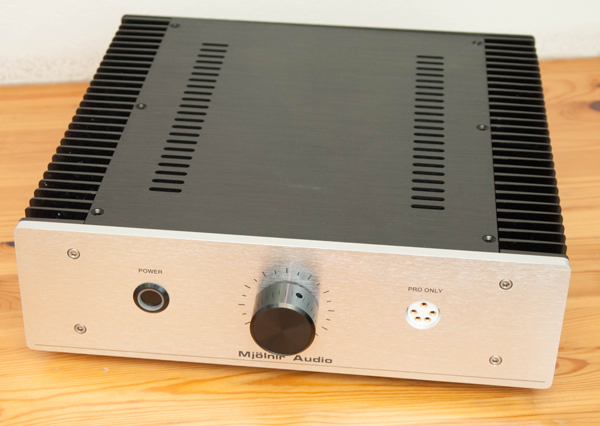
Photo 18-1: KGSS HV Carbon – front view
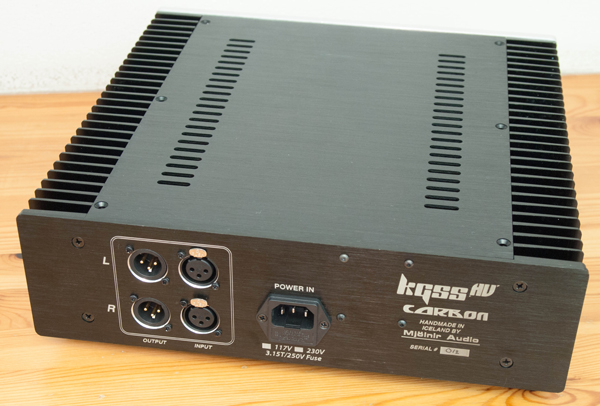
Photo 18-2: KGSS HV Carbon – rear view
More from Mjölnir!
For dynamic cans, Mjölnir has produced the new Pure Bipolar amplifier, which began life dubbed the "Dynalo Mk2." To my ears, this amp just doesn't give up, no matter how far you push it. My measurements confirmed that unlike my older, custom AMB amplifier, the Pure Bipolar saturates much like tubes, it gently goes into clipping. In fact, it has such a high output capability that I would have to add an additional attenuator in my measurement setup in order to measure its limits. So I don't know yet when this amp would reach the 1% distortion point. Maybe next episode, in my copious (!) free time. Spritzer's philosophy: "it's better to have a bit of benign distortion over the sharp cutoff you get in so many circuits. Tubes bend...they don't break so to speak..."
So there is a family resemblance between the Pure Bipolar and the Carbon HV. Then again, at these kinds of levels you would go deaf before you notice any obvious saturation! I think that gentle saturation is the partner of warm sound quality. Warmth probably is due to some euphonic distortion, since saturation is compression and compression is distortion. But count me in on a little of that! The Pure Bipolar has tube-like purity, but is solid, robust, transparent and extended. Dynamics are not compromised in any way.
Here's a table (Fig. 18-3 below) comparing measurements of THD (without noise) at 1 kHz: of my custom AMB (unbalanced) amp versus the Pure Bipolar. Absolute THD numbers do not tell us much how an amp will sound, but the values at the onset of clipping give a clue to potential sonic performance. Into 100 ohms or higher, both amps exhibit very low THD at medium levels. The Pure Bipolar distortion barely increases with increased level and it easily delivers +20 dBu (7.75 volts, 600 mW) into a 100 ohm load. However, into a 20 ohm load, the Pure Bipolar's THD measurements indicate that detail could be softened when playing super low impedance cans very loudly and I mean literally at deafening levels. Given the typical sensitivity of low impedance cans no one would ever drive them to this peak level, which would be 126 dB for the Oppo PM-3 at +10 dBu, where the distortion still measures an acceptable 0.7%. Even for short duration peaks, that would be unbearably loud. I certainly didn't put any headphones to listening tests at those levels! Even though we never would drive amps to these levels, I feel more comfortable knowing that the amp can deliver them, believing that clean performance at high levels is an indication of good performance at typical levels. To put this in perspective, when playing a classical symphony loudly, with fortes measuring 80 dB SPL on an averaging meter, momentary peaks could reach as much as 100 dB SPL measured with a peak meter. That's 26 dB below the point where the Pure Bipolar reaches 0.7% THD into 20 ohms!
As you can see, at normal levels the AMB and Pure Bipolar measure the same THD. At medium high levels, into 100 ohms, the AMB has slightly more distortion than the Pure Bipolar. But into a low impedance load, 20 ohms, at medium high levels, the AMB has significantly less total distortion than the Pure Bipolar. Keep in mind we don't know if this is benign or significant distortion without perhaps looking at its spectrum. Into any load, the unbalanced AMB clips quite distinctly around +15 dBu, whereas the balanced Pure Bipolar is like the Energizer Bunny—it keeps on going and going. Of course, it's easy for a balanced amp to deliver twice the output voltage (four times the power) with the same voltage power supply as an unbalanced amp. My AMB has a 40 volt rail, so it's no slouch. Its distortion jumps from 0.2% to 2% and higher so quickly around +15 dBu that it's impossible for me to measure the exact 1% "clip point".
I calculated an output impedance of about 0.5 ohms for the AMB and 2.4 ohms for the Pure Bipolar at 1 kHz, which are indications of two different design philosophies: far more negative feedback was used in the AMB amp.

Fig. 18-3 Mjölnir Bipolar vs. AMB M3 THD @ 1 kHz
Here's Spritzer's take on the design:
"The Dynalo circuit has been used in a lot of amps over the years but as parts have been obsolete it was time to finally update it. The biggest difference is the input stage which is now "super symmetry" as Nelson Pass calls it but it means it can take a single ended signal (RCA) and converts it to balanced without any extra circuitry. That's why the amp has only one balanced output socket, it is always balanced. Other changes are higher rail voltages and higher Class A bias for more power. To power the amplifier modules it has my own version of the ultra stable GRLV (Gold Reference Low Voltage) power supply which is just about the best power supply we can design fed by an oversized transformer. The end result of this is one of the best dynamic amps we've ever designed. It's highly transparent and able to cope with even the most demanding loads."
I loved the sound of this amp so much that I bought it; I couldn't resist, very reasonably priced at $2100. It is instantly the best-sounding dynamic headphone amp in my collection.
Well, guess what I just got to go with this new amp?
- Log in or register to post comments

